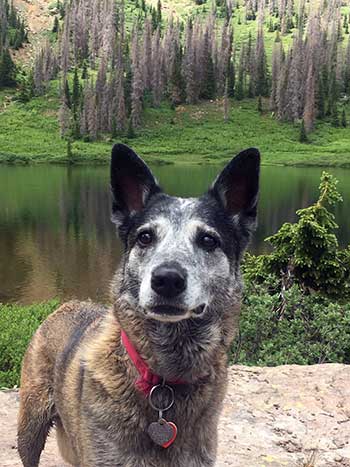BY T. S. LAST / JOURNAL STAFF WRITER
Tuesday, January 8th, 2019 at 11:35pm
Copyright © 2019 Albuquerque Journal
SANTA FE – Dave Clark says he doesn’t want anyone else to go through what he has.
Not just the horror of watching his beloved 8-year-old heeler mix choke to death in a neck snare trap, as Clark desperately tried to loosen the snare to free the dog, named Roxy.

Roxy, companion for Dave and Kathrina Clark of Española, was killed by a neck snare trap on public land. (Courtesy: Dave Clark)
The aftermath of that experience has also had an effect.
“There’s more to it than just the loss of a dog,” Clark said. “I’m having a hard time going out and walking our other dog. Every juniper tree I pass on the trail feels like a threat. It feels like I’m walking through a minefield. It takes the joy out of walking dogs.”
Clark is hoping some good may come from the tragedy. A bill being introduced in the legislative session that begins next week would prohibit the use of traps, snares and poisons on public lands in New Mexico. The New Mexico Wildlife Protection and Public Safety Act is being sponsored by state Reps. Bobby Gonzales of Taos and Matthew McQueen of Galisteo, both Democrats.
To honor the memory of Clark’s faithful dog, the bill is being pitched as “Roxy’s Law.”
Similar bills have been introduced in past legislative sessions but haven’t gotten very far.
“It has had trouble getting out of House, Energy and Natural Resources Committee,” said Mary Katherine Ray, of the Rio Grande Chapter of the Sierra Club, which is part of a coalition of groups that make up Trap Free New Mexico.
“We’re very hopeful that with the changes in the administration and the Legislature that it will be a much more wildlife-friendly committee than it has been in the past.”
Clark found Roxy about eight years ago when he was working for a coal reclamation program in the Four Corners area.
“I was headed out to one of the mines, and there was this little puppy out on the highway. She was all by herself in the middle of the road,” he said.
On Nov. 25, Clark was walking Roxy on a trail at the federal Bureau of Land Management’s Santa Cruz Lake Recreation Area near Española. “We’ve been walking dogs on that trail for 20 years,” he said of the two-mile hike down to Rio del Medio and back.
Clark and Roxy, who was off her leash, were almost finished when he heard a strange sound behind him. He turned to see Roxy caught in a neck snare.
To make matters worse, when Clark finally freed Roxy from the snare and was carrying her back to where he left his car, a bobcat that was caught in another trap, a leg-hold type, lashed out at him.
“That was a bad day,” he said. “I wouldn’t want to see anyone go through the pain that I did.”
The incident occurred on BLM land that Clark said was off-limits to trapping. He suspects the same trapper who snared Roxy also set the trap that caught the bobcat.
Clark said it’s his understanding the bobcat was put down by Game and Fish officials.
The Sierra Club’s Ray said that a change in state trapping law would apply to BLM sites. The state Game and Fish Department is in charge of wildlife “no matter where it is,” she said.
Sgt. Ben Otero of New Mexico Game and Fish did not return a phone message from the Journal Tuesday. The department issues trapping licenses for $20 apiece.
A call to the BLM’s chief communications director was met with a recorded message that states she will not be able to respond to messages due to the partial shutdown of the federal government.
Any bill to restrict trapping can expect opposition from the New Mexico Trappers Association, which states on its website that part of its purpose is “to oppose any proposed legislation which would impose unreasonable restrictions on the taking of furbearing or predator animals, or the sale of their pelts; to demand the revision or repeal of any existing law or regulation of the same nature.”
Efforts to reach someone with the NMTA for comment on Tuesday were unsuccessful.
According to its website, the NMTA works to promote the wise use of renewable fur resources and “educating the public as to the necessity of trapping and harvesting fur-bearing populations.” It also educates and trains youths and others about trapping for “sport, economic gain, or protection of livestock and other property.”
NMTA says that trapping is part of New Mexico’s rich heritage and that for some families trapping is a way of life and a sole source of income.
Newly elected Land Commissioner Stephanie Garcia Richard is pledging to remove what she said are outdated and dangerous devices from state trust lands.
“New Mexico’s future depends on healthy lands and sustainable ecosystems. Traps and snares on public land are dangerous, inhumane, environmentally destructive, and they have no place in a 21st Century economy,” Garcia Richard said in the news release from anti-trapping and other groups that announced the grim death of Roxy the dog.
Ray said she understands that traps can serve a good purpose in cases where a mountain lion poses a threat, or an endangered species needs protection.
“So there are a lot of exceptions,” she said. “But what we don’t want is the indiscriminate setting of traps. We promote our public lands and our outdoor spaces to people from other states and the time has come to stop putting people and their animals at risk.”
